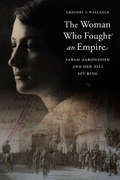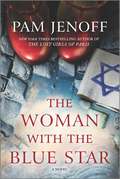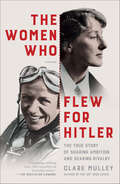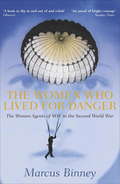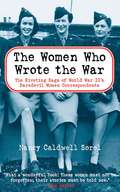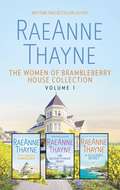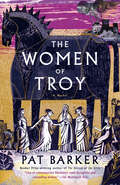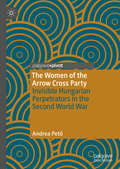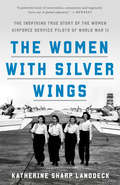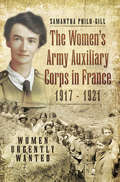- Table View
- List View
The Woman Who Fought an Empire: Sarah Aaronsohn and Her Nili Spy Ring
by Gregory J. WallanceThough she only lived to be twenty-seven, Sarah Aaronsohn led a remarkable life. The Woman Who Fought an Empire tells the improbable but true odyssey of a bold young woman—the daughter of Romanian-born Jewish settlers in Palestine—who became the daring leader of a Middle East spy ring. Following the outbreak of World War I, Sarah learned that her brother Aaron had formed Nili, an anti-Turkish spy ring, to aid the British in their war against the Ottomans. Sarah, who had witnessed the atrocities of the Armenian genocide by the Turks, believed that only the defeat of the Ottoman Empire could save the Palestinian Jews from a similar fate. Sarah joined Nili, eventually rising to become the organization’s leader. Operating behind enemy lines, she and her spies furnished vital information to British intelligence in Cairo about the Turkish military forces until she was caught and tortured by the Turks in the fall of 1917. To protect her secrets, Sarah got hold of a gun and shot herself. The Woman Who Fought an Empire, set at the birth of the modern Middle East, rebukes the Hollywood stereotype of women spies as femme fatales and is both an espionage thriller and a Joan of Arc tale.
The Woman at the Front
by Lecia CornwallA daring young woman risks everything to pursue a career as a doctor on the front lines in France during World War I, and learns the true meaning of hope, love, and resilience in the darkest of times. When Eleanor Atherton graduates from medical school near the top of her class in 1917, she dreams of going overseas to help the wounded, but her ambition is thwarted at every turn. Eleanor's parents insist she must give up medicine, marry a respectable man, and assume her proper place. While women might serve as ambulance drivers or nurses at the front, they cannot be physicians—that work is too dangerous and frightening. Nevertheless, Eleanor is determined to make more of a contribution than sitting at home knitting for the troops. When an unexpected twist of fate sends Eleanor to the battlefields of France as the private doctor of a British peer, she seizes the opportunity for what it is—the chance to finally prove herself. But there's a war on, and a casualty clearing station close to the front lines is an unforgiving place. Facing skeptical commanders who question her skills, scores of wounded men needing care, underhanded efforts by her family to bring her back home, and a blossoming romance, Eleanor must decide if she's brave enough to break the rules, face her darkest fears, and take the chance to win the career—and the love—she's always wanted.
The Woman from Heartbreak House (The Poor House Lane Sagas)
by Freda LightfootFollowing World War I, an English wife and mother faces a battle of her own, struggling to keep her family together in this moving saga. The Great War is over, and Kate is ready to welcome back Eliot with open arms. But her husband is a changed man. Kate has become used to her independence, and Eliot&’s return creates tensions both at work and at home, particularly with Kate&’s son, Callum. It tears Kate apart to see such strife between the two men she loves most. And her sister-in-law seems determined to stir up the animosity in order to benefit her own son. But when tragedy strikes, Kate cannot imagine just how much trouble Lucy's ambition can cause . . . Perfect for fans of Val Wood and Katie Flynn.&“Freda Lightfoot&’s talent for creating believable characters makes this a page-turning read.&” —Evening Chronicle&“Real people and real dramas are her mainstays.&” —The Westmorland Gazette
The Woman in Red \ La mujer en rojo (Spanish edition): una novela
by Diana GiovinazzoAnita Garibaldi, una de las mujeres más reconocidas de toda América del Sur e Italia, cobra vida y fuerza de la mano de Diana Giovinazzo. Brasil, 1839Mucho se ha hablado del revolucionario italiano Giuseppe Garibaldi, pero muy poco de su esposa y compañera de armas. La vida de Ana da Silva cambió para siempre tras conocer al sehnor Garibaldi, un mercenario contratado para liberar dos repúblicas sureñas de Brasil durante la Guerra de los farrapos. Fue amor a primera vista para una de las parejas más épicas del siglo XIX: Anita, como la llamarían más adelante, se unió de inmediato al viaje en barco de Garibaldi, una decisión inaudita para la época. Un mes después, se inició como guerrera, luchando hombro a hombro junto a su esposo, quien la consideró igual que él y sus consejeros. En esta emocionante novela histórica, Anita Garibaldi narra los acontecimientos que marcaron la historia de Brasil, Uruguay e Italia, destilando sus sueños, emociones, y desafíos en el proceso. En La mujer de rojo, Diana Giovinazzo recrea un personaje que es a un tiempo prototipo feminista y protagonista entrañable que enamorará a todo tipo de lector. Diana Giovanazzo es neoyorquina de origen italiano y una apasionada de la novela histórica y de la genealogía. Es la cocreadora del podcast literario Wine, Women and Words [Vino, mujeres y palabras]. La mujer de rojo es su primera novela.
The Woman in the Green Dress
by Tea CooperA cursed opal, a gnarled family tree, and a sinister woman in a green dress emerge in the aftermath of World War I.After a whirlwind romance, London teashop waitress Fleur Richards can&’t wait for her new husband, Hugh, to return from the Great War. But when word of his death arrives on Armistice Day, Fleur learns he has left her a sizable family fortune. Refusing to accept the inheritance, she heads to his beloved home country of Australia in search of the relatives who deserve it more.In spite of her reluctance, she soon finds herself the sole owner of a remote farm and a dilapidated curio shop full of long-forgotten artifacts, remarkable preserved creatures, and a mystery that began more than sixty-five years ago. With the help of Kip, a repatriated soldier dealing with the sobering aftereffects of war, Fleur finds herself unable to resist pulling on the threads of the past. What she finds is a shocking story surrounding an opal and a woman in a green dress. . . a story that, nevertheless, offers hope and healing for the future.This romantic mystery from award-winning Australian novelist Tea Cooper will keep readers guessing until the astonishing conclusion.&“Readers of Kate Morton and Beatriz Williams will be dazzled. The Woman in the Green Dress spins readers into an evocative world of mystery and romance in this deeply researched book by Tea Cooper. There is a Dickensian flair to Cooper&’s carefully constructed world of lost inheritances and found treasures as two indomitable women stretched across centuries work to reconcile their pasts while reclaiming love, identity and belonging against two richly moving historical settings. As soon as you turn the last page you want to start again just to see how every last thread is sewn in anticipation of its thrilling conclusion. One of the most intelligent, visceral and vibrant historical reads I have had the privilege of visiting in an age.&” —Rachel McMillan, author of The London Restoration &“Refreshing and unique, The Woman in the Green Dress sweeps you across the wild lands of Australia in a thrilling whirl of mystery, romance, and danger. This magical tale weaves together two storylines with a heart-pounding finish that is drop-dead gorgeous.&” —J&’nell Ciesielski, author of The SocialiteFull-length historical story with both romance and mysteryStand-alone novelIncludes Discussion Questions for Book Clubs
The Woman in the Sable Coat
by Elizabeth BrooksFrom the acclaimed author of The Orphan of Salt Winds, The Whispering House, and The House in the Orchard comes a passionate and fateful story of love, betrayal, and the rewards—and costs—of following your heart. At the height of the Second World War in England, twenty-two year old Nina Woodrow joins the British Royal Air Force and rebels against her careful upbringing by embarking on an illicit affair with an officer. She risks losing everything for Guy Nicholson: her comfortable home, her childhood friends, and, especially, the love of her father, an enigmatic widower. Meanwhile, in the sleepy village where Nina grew up, where the upheavals of war seem far away and divorce remains taboo, Kate Nicholson struggles to cope with her new role as the wronged wife. She finds an unlikely confidant in Nina’s father, Henry, and as they grow closer Kate finds that she's embroiled in something much murkier, and more menacing, than a straightforward friendship. Sweeping and impassioned, with pitch-perfect period detail, Elizabeth Brooks’ The Woman in the Sable Coat tells the story of two families fatally entangled in one another’s deepest, darkest secrets.
The Woman of a Thousand Names: A Novel
by Alexandra LapierreFrom the internationally bestselling author of the &“fascinating epic&” (Associated Press) Between Love and Honor comes a rich, sweeping tale based on the captivating true story of the Mata Hari of Russia, featuring a beautiful aristocrat fighting for survival during the deadly upheaval of the Russian Revolution. Born into Russian aristocracy, wealth, and security, Moura never had any reason to worry. But in the upheaval of the Bolshevik Revolution, her entire world crumbles. As her family and friends are being persecuted by Vladimir Lenin&’s ruthless police, she falls into a passionate affair with British secret agent Sir Robert Bruce Lockhart. But when he&’s abruptly and mysteriously deported from Russia, Moura is left alone and vulnerable. Now, she must find new paths for her survival, even if it means shedding her past and taking on new identities. Some will praise her tenderness and undying loyalty. Others will denounce her lies. But all will agree on one point: Moura embodies Life. Life at all cost. Set against the volatile landscape of 20th-century Russia, The Woman of a Thousand Names brings history to vivid life in a captivating tale about an extraordinary woman caught in the waves of change—with only her wits to save her.
The Woman with No Name: A Novel
by Audrey Blake"Resilience, courage, and bravery outshine the enemy is this fast-paced, historical read." — BooklistShe'll light the fire of resistance—but she may get burned…1942. Though she survived the bomb that destroyed her home, Yvonne Rudellat's life is over. She's estranged from her husband, her daughter is busy with war work, and Yvonne—older, diminutive, overlooked—has lost all purpose. Until she's offered a chance to remake herself entirely…The war has taken a turn for the worse, and the men in charge are desperate. So, when Yvonne is recruited as Britain's first female sabotage agent, expectations are low. But her tenacity, ability to go unnoticed, and aptitude for explosives set her apart. Soon enough she arrives in occupied France with a new identity, ready to set the Nazi regime ablaze.But there are adversaries on all sides. As Yvonne becomes infamous as the nameless, unstoppable woman who burns the enemy at every turn, she realizes she may lose herself to the urgent needs of the cause…Based on a true story, The Woman With No Name is a gripping story of secrets, spies, and the women behind the Resistance, from USA Today bestselling author Audrey Blake.
The Woman with Two Shadows: A Novel of WWII
by Sarah James"A riveting tale about a town and its people that officially never existed and the secrecy behind one of the Manhattan Project's top-secret cities!" —Kim Michele Richardson, New York Times bestselling author of The Book Woman's DaughterFor fans of Atomic City Girls and Marie Benedict, a fascinating historical debut of one of the most closely held secrets of World War II and a woman caught up in it when she follows her missing sister to the mysterious city of Oak Ridge, Tennessee.Lillian Kaufman hasn't heard from her twin sister since Eleanor left for a mysterious job at an Army base somewhere in Tennessee. When she learns, on an unexpected phone call, that Eleanor is missing, Lillian takes a train from New York down to Oak Ridge to clear up the matter.It turns out that the only way into Oak Ridge is to assume Eleanor's identity, which Lillian plans to do swiftly and perfectly. But Eleanor has vanished without a trace—and she's not the only one. And how do you find someone in a town so dangerous it doesn't officially exist, when technically you don't exist either?Lillian is thrust into the epicenter of the gravest scientific undertaking of all time, with no idea who she can trust. And the more she pretends to be Eleanor, the more she loses her grip on herself.
The Woman with a Purple Heart: A Novel
by Diane Hanks"Historical fiction at its finest!" —Amanda Skenandore, author of The Second Life of Mirielle West and The Nurse's SecretBased on the real life of Lieutenant Annie Fox, Chief Nurse of Hickam Hospital, The Woman with a Purple Heart is an inspiring WWII novel of heroic leadership, courage, and friendship that also exposes a shocking and shameful side of history.Annie Fox will stop at nothing to serve her country. But what happens when her country fails her?In November 1941, Annie Fox, an Army nurse, is transferred to Hickam Field, an air force base in Honolulu. The others on her transport plane are thrilled to work in paradise, but Annie sees her new duty station as the Army's way of holding the door open to her retirement. But serving her country is her calling and she will go wherever she is told.On December 7, Annie's on her way to work when the first Japanese Zero fighter plane flies low over Hickam's Parade Ground. The death and destruction that follow leave her no time to process what's happening. She rallies her nurses, and they work to save as many lives as they can. But soon their small hospital is overwhelmed. Annie drives into Honolulu to gather supplies, nurses, and several women who will donate blood. However, the nurses are Japanese Americans, and the blood donors are prostitutes. Under Annie's leadership and working together in unexpected ways, they make it through that horrific day, when one of the Japanese American nurses and Annie's friend, Kay, is arrested as a suspected subversive. As Hickam tries to recover, Annie works to find her friend and return Kay to her family. But Annie's love for her country is put to the test. How can she reconcile the American bravery and resilience she saw on December 7 with the prejudice and injustice she witnesses just a few months later?Praise for The Woman with a Purple Heart:"Vividly portrays a little-known story in a well-known time on a day that will live in infamy. A stirring read!" —Erika Robuck, national bestselling author of The Invisible Woman"A wonderful tribute to a true American hero." —Sara Ackerman, USA Today bestselling author of Radar Girls and The Codebreaker's Secret"Fast-paced and immersive. This is the kind of story that sticks with you long after turning the final page." —Elise Hooper, author of Angels of the Pacific
The Woman with the Blue Star: A Novel
by Pam Jenoff"An emotional novel that you will never forget." —Lisa Scottoline, #1 New York Times bestselling author of EternalFrom the author of The Lost Girls of Paris comes a riveting tale of courage and unlikely friendship during World War II -- Now a New York Times bestsller!1942. Sadie Gault is eighteen and living with her parents in the Kraków Ghetto during World War II. When the Nazis liquidate the ghetto, Sadie and her pregnant mother are forced to seek refuge in the perilous tunnels beneath the city. One day Sadie looks up through a grate and sees a girl about her own age buying flowers.Ella Stepanek is an affluent Polish girl living a life of relative ease with her stepmother, who has developed close alliances with the occupying Germans. While on an errand in the market, she catches a glimpse of something moving beneath a grate in the street. Upon closer inspection, she realizes it&’s a girl hiding.Ella begins to aid Sadie and the two become close, but as the dangers of the war worsen, their lives are set on a collision course that will test them in the face of overwhelming odds. Inspired by incredible true stories, The Woman with the Blue Star is an unforgettable testament to the power of friendship and the extraordinary strength of the human will to survive.Highly recommended by Entertainment Weekly, Washington Post, CNN, BookTrib, Goodreads, Betches, AARP, Frolic, SheReads, and more!Don&’t miss Pam Jenoff&’s new novel, Code Name Sapphire, a riveting tale of bravery and resistance during World War II.Read these other sweeping epics from New York Times bestselling author Pam Jenoff:The Lost Girls of ParisThe Orphan&’s TaleThe Ambassador&’s DaughterThe Diplomat&’s WifeThe Last Summer at Chelsea BeachThe Kommandant&’s GirlThe Winter Guest
The Women Who Flew for Hitler: The True Story of Soaring Ambition and Searing Rivalry
by Clare MulleyBiographers' Club Prize-winner Clare Mulley’s The Women Who Flew for Hitler—a dual biography of Nazi Germany's most highly decorated women pilots.Hanna Reitsch and Melitta von Stauffenberg were talented, courageous, and strikingly attractive women who fought convention to make their names in the male-dominated field of flight in 1930s Germany. With the war, both became pioneering test pilots and were awarded the Iron Cross for service to the Third Reich. But they could not have been more different and neither woman had a good word to say for the other.Hanna was middle-class, vivacious, and distinctly Aryan, while the darker, more self-effacing Melitta came from an aristocratic Prussian family. Both were driven by deeply held convictions about honor and patriotism; but ultimately, while Hanna tried to save Hitler’s life, begging him to let her fly him to safety in April 1945, Melitta covertly supported the most famous attempt to assassinate the Führer. Their interwoven lives provide vivid insight into Nazi Germany and its attitudes toward women, class, and race.Acclaimed biographer Clare Mulley gets under the skin of these two distinctive and unconventional women, giving a full—and as yet largely unknown—account of their contrasting yet strangely parallel lives, against a changing backdrop of the 1936 Olympics, the Eastern Front, the Berlin Air Club, and Hitler’s bunker. Told with brio and great narrative flair, The Women Who Flew for Hitler is an extraordinary true story, with all the excitement and color of the best fiction.Biographers' Club Prize-winner Clare Mulley’s The Women Who Flew for Hitler—a dual biography of Nazi Germany's most highly decorated women pilots.Hanna Reitsch and Melitta von Stauffenberg were talented, courageous, and strikingly attractive women who fought convention to make their names in the male-dominated field of flight in 1930s Germany. With the war, both became pioneering test pilots and were awarded the Iron Cross for service to the Third Reich. But they could not have been more different and neither woman had a good word to say for the other.Hanna was middle-class, vivacious, and distinctly Aryan, while the darker, more self-effacing Melitta came from an aristocratic Prussian family. Both were driven by deeply held convictions about honor and patriotism; but ultimately, while Hanna tried to save Hitler’s life, begging him to let her fly him to safety in April 1945, Melitta covertly supported the most famous attempt to assassinate the Führer. Their interwoven lives provide vivid insight into Nazi Germany and its attitudes toward women, class, and race.Acclaimed biographer Clare Mulley gets under the skin of these two distinctive and unconventional women, giving a full—and as yet largely unknown—account of their contrasting yet strangely parallel lives, against a changing backdrop of the 1936 Olympics, the Eastern Front, the Berlin Air Club, and Hitler’s bunker. Told with brio and great narrative flair, The Women Who Flew for Hitler is an extraordinary true story, with all the excitement and color of the best fiction.
The Women Who Lived For Danger: The Agents Of The Special Operations Executive
by Marcus BinneyIn World War II, 37 women were dropped in occupied France to work as Special Operations Executive agents and 'set Europe ablaze'. 13 never returned. They were executed in Hitler's concentration camps. This is the fascinating story of eight of those female agents, all striking beauties (despite the need to be inconspicuous), all from civilian life, who were warned of the likelihood of arrest, torture and a brutal death before they volunteered. None demurred. These young women were given months of arduous fitness, gun, explosives, endurance and code training before parachuting into occupied territory. But Women Who Lived for Danger also contains eight very personal tales. Why did these women volunteer? Where did they come from? Marcus Binney tells of a life of Resistance work and uncover operations, clandestine activities and even armed combat, and a constant fear of discovery. But above this book tells of extreme bravery and devotion to duty.
The Women Who Lived For Danger: The Women Agents Of Soe In The Second World War
by Marcus BinneyIn World War II, 37 women were dropped in occupied France to work as Special Operations Executive agents and 'set Europe ablaze'. 13 never returned. They were executed in Hitler's concentration camps. This is the fascinating story of eight of those female agents, all striking beauties (despite the need to be inconspicuous), all from civilian life, who were warned of the likelihood of arrest, torture and a brutal death before they volunteered. None demurred. These young women were given months of arduous fitness, gun, explosives, endurance and code training before parachuting into occupied territory. But Women Who Lived for Danger also contains eight very personal tales. Why did these women volunteer? Where did they come from? Marcus Binney tells of a life of Resistance work and uncover operations, clandestine activities and even armed combat, and a constant fear of discovery. But above this book tells of extreme bravery and devotion to duty.
The Women Who Wrote the War: The Compelling Story of the Path-breaking Women War Correspondents of World War II
by Nancy Caldwell SorelHere's how a hundred brave American women left their families and entered the combat-zone to chronicle what they saw. Nancy Sorel's portrait pays homage to these unsung heroes. They came from Boston, New York, Milwaukee, and St. Louis; from Yakima, Washington; Austin, Texas; and Sioux City, Iowa; from San Francisco and all points east. They left comfortable homes and safe surroundings for combat-zone duty. As women war correspondents, they brought to the battlefields of World War II a fresh optic, and reported back home what they witnessed with a new sensibility. Their experience was at once wide-ranging and intimate, devastating at one moment, heartwarming the next. In their ranks we encounter world-famous photojournalist Margaret Bourke-White, the only Western photographer to cover the Nazi invasion of the USSR; Martha Gellhorn, writer and wife of Ernest Hemingway, who presciently reported on the menace of fascism; The New Yorker's Janet Flanner, recording the bleak realities of life in post-liberation France; and Marguerite Higgins, who dared enter the concentration camp at Dachau just ahead of the American army. In her graphic, seamless narrative, Nancy Sorel weaves together the lives and times of these gutsy, incomparable women, assuring them their rightful place in this century's history.
The Women and War Reader
by Lois Ann Lorentzen Jennifer TurpinWar affects women in profoundly different ways than men. Women play many roles during wartime: they are "gendered" as mothers, as soldiers, as munitions makers, as caretakers, as sex workers. How is it that womanhood in the context of war may mean, for one woman, tearfully sending her son off to war, and for another, engaging in civil disobedience against the state? Why do we think of war as "men's business" when women are more likely to be killed in war and to become war refugees than men?<p><p> The Women and War Reader brings together the work of the foremost scholars on women and war to address questions of ethnicity, citizenship, women's agency, policy making, women and the war complex, peacemaking, and aspects of motherhood. Moving beyond simplistic gender dichotomies, the volume leaves behind outdated arguments about militarist men and pacifist women while still recognizing that there are patterns of difference in men's and women's relationships to war.<p> The Women and War Reader challenges essentialist, class-based, and ethnocentric analysis. A comprehensive volume covering such regions as the former Yugoslavia, Northern Ireland, Israel and Palestine, Iran, Nicaragua, Chiapas, South Africa, Afghanistan, Sri Lanka, South Korea, and India, it will provide a much-needed resource. The volume includes the work of over 35 contributors, including Cynthia Enloe, Sara Ruddick, V. Spike Peterson, Betty Reardon, April Carter, Leila J. Rupp, Harriet Hyman Alonso, Francine D'Amico, Nancy Scheper-Hughes, and Carolyn Nordstrom.
The Women of Brambleberry House Collection Volume 1: An Anthology (The Women of Brambleberry House)
by RaeAnne ThayneEnjoy the rocky shores of Cannon Beach, Oregon in the first three books of New York Times bestselling author RaeAnne Thayne’s The Woman of Brambleberry House series, together for the first time!The Daddy MakeoverEben Spencer learned long ago to keep his eye on the ball and his emotions under wraps. And where had this philosophy got him so far? In business, to the pinnacle of success. In his personal life, it brought him one beloved, if unhappy, little girl, and one shattered marriage. He is not about to embark on another one anytime soon….Until he meets Sage Benedetto. The bewitching woman is everything Eben is not—warm, emotional, open—and everything he never dreamed he’d want. But lately he’s having very different dreams….His Second-Chance FamilyWhen she was sixteen, Julia Blair found more than fun in the sun on the sands of Cannon Beach. She found a home—especially in the arms of Will Garrett—and she thought that life stretched out in front of her….Now she’s thirty-two, and though life may not have worked out the way she planned, here she is: back in Cannon Beach, with her two little children in tow. Only to find Will Garrett there, too. Julia believes he can still make all her dreams come true. The question is, will he let her into his heart to do the same for him?The Soldier’s SecretTo find out who was claiming ownership of the only place he’d ever called home, Harry Maxwell knew he’d have to practice a little deception. So the wounded lieutenant changed his name a little. Altered a few facts. All for a good cause—get in, get the truth, get out.Then he meets the Brambleberry House heir presumptive. Anna Galvez is captivating in ways he hadn’t even known existed. Still, after spending time with her, he wants the house more than ever. But only if she’s in it.
The Women of Brambleberry House Collection: His Second-chance Family / A Soldier's Secret (The\women Of Brambleberry House Ser.)
by RaeAnne ThayneWelcome to Cannon Beach, Oregon where New York Times bestselling author RaeAnne Thayne introduces the Women of Brambleberry House in four heartwarming and emotional romances perfect for fans of Debbie Macomber and Robyn Carr!The Daddy MakeoverEben Spencer learned long ago to keep his eye on the ball and his emotions under wraps. And where had this philosophy got him so far? In business, to the pinnacle of success. In his personal life, it brought him one beloved, if unhappy, little girl, and one shattered marriage. He is not about to embark on another one anytime soon….Until he meets Sage Benedetto. The bewitching woman is everything Eben is not—warm, emotional, open—and everything he never dreamed he’d want. But lately he’s having very different dreams….His Second-Chance FamilyWhen she was sixteen, Julia Blair found more than fun in the sun on the sands of Cannon Beach. She found a home—especially in the arms of Will Garrett—and she thought that life stretched out in front of her….Now she’s thirty-two, and though life may not have worked out the way she planned, here she is: back in Cannon Beach, with her two little children in tow. Only to find Will Garrett there, too. Julia believes he can still make all her dreams come true. The question is, will he let her into his heart to do the same for him?The Soldier’s SecretTo find out who was claiming ownership of the only place he’d ever called home, Harry Maxwell knew he’d have to practice a little deception. So the wounded lieutenant changed his name a little. Altered a few facts. All for a good cause—get in, get the truth, get out.Then he meets the Brambleberry House heir presumptive. Anna Galvez is captivating in ways he hadn’t even known existed. Still, after spending time with her, he wants the house more than ever. But only if she’s in it.A Soldier’s ReturnReturning home to Cannon Beach and living in Brambleberry House, a place where good things seemed destined to happen, had brought Melissa Fielding and her young daughter such joy. Perhaps it was no accident when the single mom “bumped” into Eli Sanderson, and discovered the handsome doctor was also back in town. The ex-soldier was still so captivating, but also more guarded. Was now the time to put old ghosts to rest?
The Women of Troy: A Novel (The Women of Troy Series)
by Pat BarkerA daring and timely feminist retelling of The Iliad from the perspective of the women of Troy who endured it—an extraordinary follow up to The Silence of the Girls from the Booker Prize-winning author of The Regeneration Trilogy and &“one of contemporary literature&’s most thoughtful and compelling writers" (The Washington Post).Troy has fallen and the victorious Greeks are eager to return home with the spoils of an endless war—including the women of Troy themselves. They await a fair wind for the Aegean.It does not come, because the gods are offended. The body of King Priam lies unburied and desecrated, and so the victors remain in suspension, camped in the shadows of the city they destroyed as the coalition that held them together begins to unravel. Old feuds resurface and new suspicions and rivalries begin to fester.Largely unnoticed by her captors, the one time Trojan queen Briseis, formerly Achilles's slave, now belonging to his companion Alcimus, quietly takes in these developments. She forges alliances when she can, with Priam's aged wife the defiant Hecuba and with the disgraced soothsayer Calchas, all the while shrewdly seeking her path to revenge.
The Women of the Arrow Cross Party: Invisible Hungarian Perpetrators in the Second World War
by Andrea PetőThis book analyses the actions, background, connections and the eventual trials of Hungarian female perpetrators in the Second World War through the concept of invisibility. It examines why and how far-right women in general and among them several Second World War perpetrators were made invisible by their fellow Arrow Cross Party members in the 1930s and during the war (1939-1945), and later by the Hungarian people’s tribunals responsible for the purge of those guilty of war crimes (1945-1949). It argues that because of their ‘invisibilization’ the legacy of these women could remain alive throughout the years of state socialism and that, furthermore, this legacy has actively contributed to the recent insurgence of far-right politics in Hungary. This book therefore analyses how the invisibility of Second World War perpetrators is connected to twenty-first century memory politics and the present-day resurgence of far-right movements.
The Women with Silver Wings: The Inspiring True Story of the Women Airforce Service Pilots of World War II
by Katherine Sharp Landdeck&“With the fate of the free world hanging in the balance, women pilots went aloft to serve their nation. . . . A soaring tale in which, at long last, these daring World War II pilots gain the credit they deserve.&”—Liza Mundy, New York Times bestselling author of Code Girls When the Japanese attacked Pearl Harbor in December 1941, Cornelia Fort was already in the air. At twenty-two, Fort had escaped Nashville&’s debutante scene for a fresh start as a flight instructor in Hawaii. She and her student were in the middle of their lesson when the bombs began to fall, and they barely made it back to ground that morning. Still, when the U.S. Army Air Forces put out a call for women pilots to aid the war effort, Fort was one of the first to respond. She became one of just over 1,100 women from across the nation to make it through the Army&’s rigorous selection process and earn her silver wings. The brainchild of trailblazing pilots Nancy Love and Jacqueline Cochran, the Women Airforce Service Pilots (WASP) gave women like Fort a chance to serve their country—and to prove that women aviators were just as skilled as men. While not authorized to serve in combat, the WASP helped train male pilots for service abroad, and ferried bombers and pursuits across the country. Thirty-eight WASP would not survive the war. But even taking into account these tragic losses, Love and Cochran&’s social experiment seemed to be a resounding success—until, with the tides of war turning, Congress clipped the women&’s wings. The program was disbanded, the women sent home. But the bonds they&’d forged never failed, and over the next few decades they came together to fight for recognition as the military veterans they were—and for their place in history.
The Women's Army Auxiliary Corps in France, 1917–1921: Women Urgently Wanted
by Samantha Philo-GillIn March 1917, the first women to be enrolled into the British Army joined the newly formed Womens Army Auxiliary Corps (WAAC). The women substituted men in roles that the Army considered suitable, thereby freeing men to move up the line. The WAACs served, for example, as cooks, drivers, signallers, clerks, as well as gardeners in the military cemeteries. Due to their exemplary service, Queen Mary gave her name to the Corps in April 1918 and it became Queen Marys Army Auxiliary Corps (QMAAC). By the time the Corps was disbanded in 1921, approximately 57,000 women had served both at home and in France.This book details the establishment of the Corps and subsequently explores the experience of the WAACs who served in France. It follows the women from enrollment to the camps and workplaces overseas, through to their experiences of the Spring Offensive of 1918, the Armistice and demobilization. The final chapter reviews how the women have been remembered in art, literature, museums and memorials. Throughout the book, the author locates the women in a society at war and examines how they were viewed by the Army, the general public and the press. The author draws on a wide range of sources to provide the background and uses the oral and written testimonies of the women themselves to tell their stories. This book will be of interest to social, womens and military historians, as well as family history researchers.
The Women's Auxiliary Air Force
by Vicki BeebyLose yourself in these charming tales of sisterhood and sweeping romance. Includes all three books in the heartwarming Ops Room Girls series; The Ops Room Girls, Christmas with the Ops Room Girls and Victory for the Ops Room Girls.The Ops Room Girls: It is 1939 and working class Evie Bishop has received a scholarship to study mathematics at Oxford when war turns her life upside down. Evie must seek a new future for herself and joins the Women’s Auxiliary Air Force as an Ops Room plotter. She soon befriends two other WAAFs, May and Jess. Together they overcome challenges, navigate new romances and keep their pilots safe in the skies. Yet the German bombers seem to know more than they should about the base’s operations, and soon Evie, May and Jess are caught up in a world more dangerous than they ever imagined…Christmas with the Ops Room Girls: When Jess suggests a pantomime to boost morale on the station, May is desperate to help, but is held back by her own insecurities. With her low self-esteem also affecting her relationship with Squadron Leader Peter Travis, May is fed up with being her own worst enemy and decides to take charge of her destiny. But the past she ran from comes back to haunt her, putting her newfound confidence to test. Can May, Jess and Evie work together once again to overcome the challenges of war – and of their own hearts?Victory for the Ops Room Girls: With Jess newly promoted to Filterer Officer at RAF Fighter Command HQ, she is delighted to be reunited with Evie and May in London. However, now that they can enjoy socialising in the city, Jess fears her friends will discover the secret she keeps there. Matters are complicated when a film company arrives at Bentley Priory to make a morale-boosting movie about the RAF. The lead actor is none other than Leonard Steele, a man from Jess’s past who could ruin everything she has worked so hard to build. As her past and present collide, will Jess find the strength to fight for her future?This gripping and emotional wartime saga series is perfect for fans of Daisy Styles, Kate Thompson and Rosie Clarke.Praise for Vicki Beeby‘Vicki Beeby is a saga author to watch.’ Margaret Dickinson, Sunday Times Top Ten bestselling author‘An exceptional historical saga about young women forging new paths in an uncertain world at war… rich with historical detail, and a must read for historical fiction fans.’ Andie Newton, author of The Girl I Left Behind‘I loved this series from start to finish. I shall miss these girls and their wartime experiences… truly delightful and beautifully written.’ ***** Reader review‘Vicki really brings her characters to life in such a way that I’m actually feeling a little sad now that the series has ended. I can’t wait to read whatever Vicki writes next.’ ***** Reader review‘I loved, loved, loved this series. The suspense, the mystery, and the chemistry within this narrative is spot on. I loved the ending… perfect fit for a perfect series.’ ***** Reader review
The Women's March: A Novel of the 1913 Woman Suffrage Procession
by Jennifer ChiaveriniNew York Times bestselling author Jennifer Chiaverini returns with The Women’s March, an enthralling historical novel of the women’s suffrage movement inspired by three courageous women who bravely risked their lives and liberty in the fight to win the vote.Twenty-five-year-old Alice Paul returns to her native New Jersey after several years on the front lines of the suffrage movement in Great Britain. Weakened from imprisonment and hunger strikes, she is nevertheless determined to invigorate the stagnant suffrage movement in her homeland. Nine states have already granted women voting rights, but only a constitutional amendment will secure the vote for all.To inspire support for the campaign, Alice organizes a magnificent procession down Pennsylvania Avenue in Washington, DC, the day before the inauguration of President-elect Woodrow Wilson, a firm antisuffragist.Joining the march is thirty-nine-year-old New Yorker Maud Malone, librarian and advocate for women’s and workers’ rights. The daughter of Irish immigrants, Maud has acquired a reputation—and a criminal record—for interrupting politicians’ speeches with pointed questions they’d rather ignore.Civil rights activist and journalist Ida B. Wells-Barnett resolves that women of color must also be included in the march—and the proposed amendment. Born into slavery in Mississippi, Ida worries that white suffragists may exclude Black women if it serves their own interests.On March 3, 1913, the glorious march commences, but negligent police allow vast crowds of belligerent men to block the parade route—jeering, shouting threats, assaulting the marchers—endangering not only the success of the demonstration but the women’s very lives.Inspired by actual events, The Women’s March offers a fascinating account of a crucial but little-remembered moment in American history, a turning point in the struggle for women’s rights.
The Women's Orchestra of Auschwitz: A Story of Survival
by Anne SebbaTHE INSTANT USA TODAY BESTSELLERMoving and powerful, this is a vivid portrait of the women who came together to form an orchestra in order to survive the horrors of Auschwitz. New York Times bestselling author of Les Parisiennes and That Woman: A Life of Wallis Simpson now examines how a disparate band of young girls struggled to overcome differences and little musical knowledge to please the often-sadistic Nazi overseers.In 1943, German SS officers in charge of Auschwitz-Birkenau ordered that an orchestra be formed among the female prisoners. Almost fifty women and girls from eleven nations were drafted into a band that would play in all weathers marching music to other inmates, forced laborers who left each morning and returned, exhausted and often broken, at the end of the day. While still living amid the harshest of circumstances, with little more than a bowl of soup to eat, they were also made to give weekly concerts for Nazi officers, and individual members were sometimes summoned to give solo performances. For almost all of the musicians chosen to take part, being in the orchestra saved their lives. But at what cost? What role could music play in a death camp? What was the effect on those women who owed their survival to their participation in a Nazi propaganda project? And how did it feel to be forced to provide solace to the perpetrators of a genocide that claimed the lives of their family and friends? In The Women's Orchestra of Auschwitz, award-winning historian Anne Sebba traces these tangled questions of deep moral complexity with sensitivity and care. From Alma Rosé, the orchestra's main conductor, niece of Gustav Mahler and a formidable pre-war celebrity violinist, to Anita Lasker-Wallfisch, its teenage cellist and last surviving member, Sebba draws on meticulous archival research and exclusive first-hand accounts to tell the full and astonishing story of the orchestra, its members, and the response of other prisoners for the first time.
